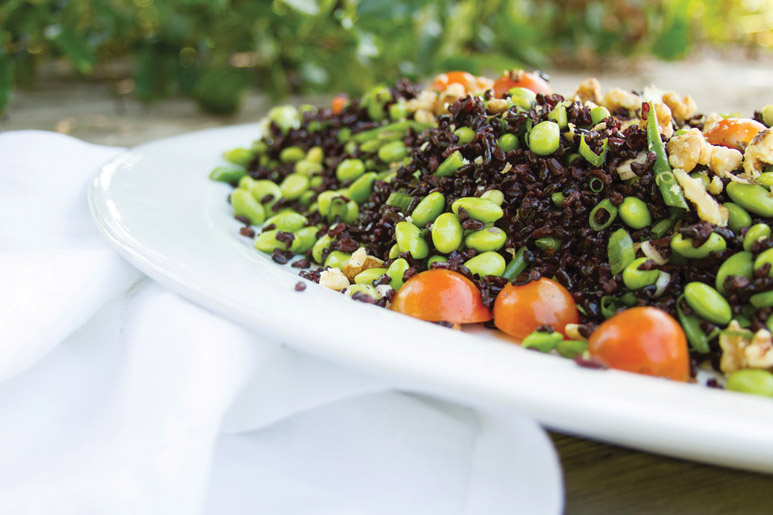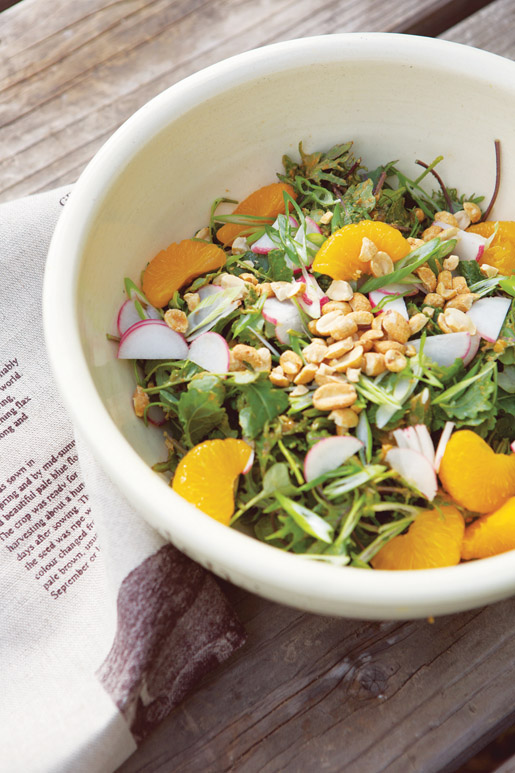Soups and Salads are more than side dishes.
Combined—or even alone—they can make a satisfying and savory meal. They also allow us to include antioxidant and nutrient-rich vegetables to our daily menu. Try a few of these recipes for spring.
We get rave reviews on our soups at the Wellness Kitchen, and guests are always surprised at just how easy it is to make a delicious pot of soup.
Red Carrot Soup
We eat with our eyes as well as our taste buds. This brilliant-colored soup is wonderfully flavorful. The natural sweetness of the carrots and the earthiness of the beets make it a great accompaniment to any meal. The vibrant color also means a very high antioxidant level, which helps fight certain types of cancer.
1 tablespoon olive oil
4 large shallots, sliced
3 sprigs thyme
2 bay leaves
Pinch of dried red pepper flakes
3 pounds carrots, peeled, sliced
1 pound trimmed beets, peeled, cut into ½ inch pieces
2 teaspoons ground coriander
2 quarts organic broth
2 tablespoons red wine vinegar
Sea salt
Freshly ground black pepper
¼ cup plain Greek yogurt or vegan yogurt
¼ cup pumpkin seeds, toasted
- Heat olive oil in large soup pot over medium-high heat. Add sliced shallots, thyme leaves, bay leaves, and red pepper flakes. Cook for three minutes.
- Add carrots, beets, coriander, and broth. Bring to a boil, then reduce to a simmer for 20 minutes.
- Discard the bay leaves.
- Purée soup in batches in a blender or food processor until smooth. Return to soup pot.
- Stir in the vinegar. Season to taste with salt and pepper.
- Garnish with a dollop of yogurt and the toasted pumpkin seeds.
Serves: 12; calories per serving: 75; dietary equivalent: 2 vegetable
Food Tip
Finishing a soup with a garnish always makes it more appetizing. The creaminess of the yogurt and the crunchiness of the pumpkin seeds add interest and texture in contrast to the velvety consistency of the soup.
Salads are an effective way of eating wholesome foods without using a lot of fancy cooking techniques. They also don’t have to be boring iceberg lettuce/Italian dressing combos. You can find a whole spectrum of flavors and textures just by layering and combining ingredients. With a wide variety of produce found in most markets year round, it’s easy to put many delicious blends on your plate, whether as a side dish or a satisfying meal. Keep fresh, seasonal greens in the refrigerator and then let your imagination take over—add a can of beans, proteins, whole grains, a small amount of cheese, nuts, blanched or grilled vegetables, or fresh fruit.

Black Rice and Edamame Salad with Meyer Lemon Vinaigrette
I truly believe we eat with our eyes, not just our taste buds, and this salad is a perfect example of that. I love to serve this salad on a buffet; the black rice color is stunning, providing the perfect backdrop for green and red vegetables. The nutty flavor of the black rice complements the flavor of the vegetables with a punch from the lemon vinaigrette.
Years ago, black rice—known in China as forbidden rice—was cultivated in very small amounts and only for the emperors’ consumption, but nowadays, you can find it in most markets. Black rice’s nutritional profile is much higher than any other rice, due to a high antioxidant level, making it an excellent choice for health benefits, too.
1 cup black rice, rinsed
2 cups water
¼ cup Meyer lemon juice or 3 tablespoons regular lemon
juice
2 tablespoons white wine vinegar
2 tablespoons water
1 tablespoon agave nectar or honey
2 tablespoons olive oil
½ cup walnuts, measured then toasted and chopped
4 green onions, thinly sliced
1 cup frozen shelled edamame, thawed
1 cup halved grape tomatoes
1 cup thinly sliced green beans
Sea salt
Freshly ground black pepper
- In a medium saucepan, add rice and water; bring to a boil, then cover and reduce to simmer. Cook rice until just tender, about 35–40 minutes. Drain well,spread out on a rimmed baking sheet, and let cool.
- Whisk lemon juice, vinegar, water, and sweetener in a small bowl. Whisking constantly, gradually drizzle in the oil to emulsify.
- In a large bowl, toss rice, walnuts, green onions, edamame, tomatoes, and green beans with the vinaigrette.
Season to taste with salt and pepper.
Serves: 8; calories per serving: 235; dietary equivalent: 1 carbohydrate, ½ oz. protein, 2 fats
Nutrition Basics
Black rice contains five times more fiber than white rice and more than double the fiber of brown rice. The black color denotes a very high antioxidant level (similar to blueberries) and has been shown to decrease cholesterol and promote heart health. Soaking black rice, like many whole grains, overnight—or even for a few hours in cold water before cooking—speeds up the cooking time.

Thai Kale Salad
As a nutritionist, I cannot say enough about kale’s health benefits; as a foodie, I sometimes wish we would move on to the next trendy green. I do love kale when it’s cooked in braises, soups, and stews. But I think I have eaten too many tough and bitter kale salads for their health benefits without otherwise being excited about them . . . until now. The secret? Use baby kale, or micro kale (often available prewashed in bags)—it’s tender, less bitter, and so much more edible. The Thai peanut dressing is well-matched to the robust flavor of the kale, so now I have seconds on a salad that is super healthy and delicious! Dress your salad lightly with this dressing; it’s flavor-packed, so a small amount goes a long way. Use any leftover dressing in a vegetable stir-fry.
¼ cup natural chunky peanut butter
1 tablespoon unseasoned rice vinegar
1 tablespoon tamari or reduced-sodium soy sauce
2 teaspoons sesame oil
1 tablespoon finely grated fresh ginger
2 teaspoons minced garlic
1 tablespoon sesame seeds
1 teaspoon Sriracha sauce
2 tablespoons water
1 pound of baby kale, or micro kale
4 scallions, sliced on the diagonal
4 large radishes, julienned or thinly-sliced half-moons
1 cup mandarin oranges packed in juice, drained
2 tablespoons salted peanuts, measured then roughly chopped
- Combine the peanut butter, vinegar, tamari, sesame oil, ginger, garlic, sesame seeds, Sriracha, and water in a food processor or blender. Purée until smooth, adding more water if needed.
- Place the kale in a large bowl and toss with some of the dressing. Add the scallions, radishes, and orange segments; combine well.
- To serve, transfer the salad to a platter and garnish with peanuts. Remaining dressing may be covered and stored in the refrigerator for up to 3 days.
Serves: 8; calories per serving: 80; dietary equivalent: 1 vegetable, fat
Nutrition Basics
If baby kale is still too much for your taste buds, try mixing it in with other greens, baby lettuces, or spinach. All dark leafy greens are rich in antioxidants and vitamins A, C, and K and folic acid, so any combination has great health benefits.
Excerpted from The Wellness Kitchen by Paulette Lambert Copyright © 2015 by Westlake Wellbeing Properties, LLC and published by F+W Media, Inc. Used by permission of the publisher. All rights reserved. Photos courtesy of Harper Smith Photography, Daydreamer Productions. Cover design by Frank Rivera.
Purchase The Wellness Kitchen here.
Paulette Lambert RD CDE is the Director of Nutrition for the California Health & Longevity Institute on the grounds of the Four Seasons Hotel in Westlake Village. She is also the weight loss expert on ABC’s Extreme Makeover: Weight Loss Edition. As the Director of Nutrition, she develops nutrition programs for her clients as well as leads workshops for individuals and corporate groups. She can be found at the California Health & Longevity Institute’s Wellness Kitchen online at: BetterHealthBeginsHere.com
